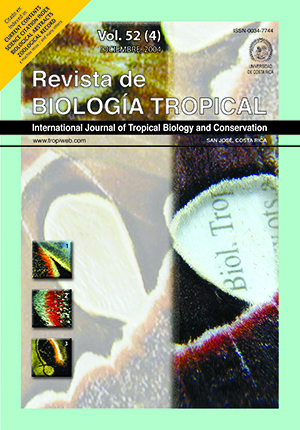Abstract
A population of 216 specimens of Stenocereus eichlamii (Cactaceae, Subfamily Cereoideae) was surveyed for Triatoma ryckmani (vector of Chagas disease) in a one hectare plot of semiarid habitat in Guatemala. Out of 44 plants that had dead and dry sections, 24 plants had a total of 103 specimens of T. ryckmani. In comparison with other areas of Guatemala, T. ryckmani is well established in the semiarid ecosystem (Infestation index 54.5, density = 2.3 and crowding index 4.3). The insects were mainly found (52.4%) in the dead portions of S. eichlamii 2.0 to 3.2 m above the ground (X² = 26.0, P< 0.00001), followed by dry cactus sections between 3.2 and 5.0 m (35.9%). They were less frequent 0.2 to 2.0 m above the ground. A considerable proportion (75.7%) had no aparent blood in their digestive systems. To determine the presence of flagellates, 43 of the bugs were dissected, but none were found. This is the first report on T. ryckmani population dynamics in this habitat.References
Aldana, E. & E. Lizano. 2004. Indice de defecación y éxito reproductivo de Triatoma maculata (Hemiptera,
Reduviidae) en condiciones de laboratorio. Rev. Biol. Trop. 52: 927-930.
Anonymous, 1966. Hoja cartográfica El Progreso, no. 1612 II. Esc. 1:50 000, color. Mapas topográficos
de la república de Guatemala. Editorial Nacional. Guatemala.
Carcavallo R., R. Zeledón, J. Jurberg & I. Galindez. 1996. Morfología externa de Triatoma ryckmani Zeledón y Ponce, 1972. Vista através da Microscopia Electrónica de Varredura. Rev. Mem. Inst. Oswaldo
Cruz. 91(6): 727-731.
Jurberg, J., C. Galvao, I. Galindez, R. Carcavallo, C. Mena & S. Curto. 1996. Distribución geográfica y dispersión altitudinal de las especies del género Triatoma Laporte, 1832 de Norte América, América Central y el Caribe. Rev. Entomol. & Vect. 3(4): 87-117.
Lent H & P. Wygodzinsky. 1979. Revision of the Triatominae (Hemiptera, Reduviidae) and their significance as vectors of Chagas disease. Bull. American. Mus. Nat. Hist. 163: 125-520.
Schofield, C. 1994. Triatominae – Biology & Control. Eurocommunica Publications, West Sussex, UK.
Sherlock I & P. Morera. 1988. Alótipo macho de Triatoma ryckmani Zeledón y Ponce, 1972. Rev. Biol. Trop.
: 423-428.
Stanley P. 1976. Flora de Guatemala. Chicago: Natural History Museum. Fieldana Botany. Vol 24(7):
-210.
Tabaru, Y., C. Monroy, A. Rodas, M. Mejía & R. Rosales. 1999. The geographical distribution of vectors of
Chagas´disease and populations at risk of infection in Guatemala. Rev. Med. Entomol. Zool. 50(1): 9-17.
Zeledón R & C. Ponce. 1972. Descripción de una nueva especie de Triatoma de Honduras, América Central (Hemiptera, Reduviidae). Rev. Biol. Trop. 20: 275-279.
##plugins.facebook.comentarios##

This work is licensed under a Creative Commons Attribution 4.0 International License.
Copyright (c) 2004 Revista de Biología Tropical


